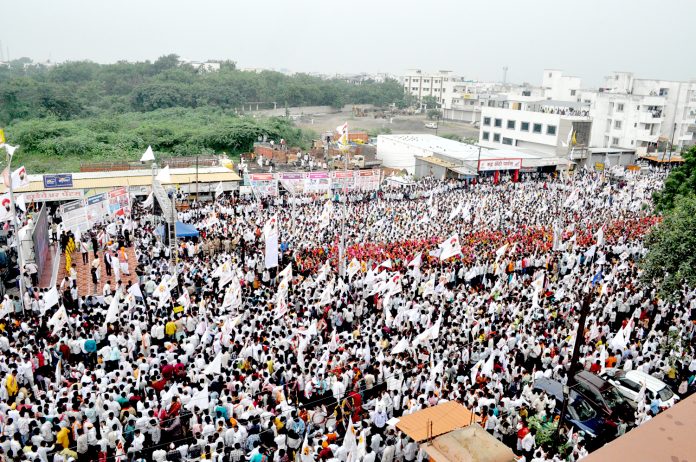 – Ahmed Noor Qureshi
– Ahmed Noor Qureshi
The Maharashtra government’s decision to accept the demands of Maratha reservation activist Manoj Jarange, who ended his five-day fast on September 2, has set off a fresh wave of caste conflicts across the state.
Jarange’s key demands included implementing the Hyderabad (1918) and Satara (1884) gazettes to facilitate Kunbi caste certificates for Marathas, thereby paving the way for their inclusion in the Other Backward Classes (OBC) category. BJP Chief Minister Devendra Fadnavis assured that OBC quotas would not be diluted, the move has sparked anger among OBC leaders, who see it as a direct encroachment on their hard-earned rights.
OBC Leaders Cry Foul
Senior NCP (Ajit Pawar faction) leader and Food and Civil Supplies Minister Chhagan Bhujbal lashed out at the government, accusing it of succumbing to “mobocracy.”
“The Maratha community is not backward, and the Supreme Court has already said this. They hold power through sugar factories and cooperatives. The government is trying to push them into the OBC category at the cost of others,” Bhujbal argued. Maratha community consists 30 percent population of Maharashtra is politically dominated.
OBC Congress leader Vijay Wadettiwar has convened OBC leaders and announced a morcha in Nagpur on October 10. “There are 374 castes in the OBC category, and their reservation is in danger,” he warned.
The unrest has already taken a tragic turn. In Latur, a 35-year-old OBC youth allegedly died by suicide, fearing erosion of OBC quotas.
Muslim Views
Muslims, who have 36 sub-castes under the OBC category, also expressed concern. All India Muslim OBC Organisation president Shabbir Ansari said Maratha inclusion could affect OBC reservations. However, Muslims have often stood in solidarity with Maratha protests, providing food and water during agitations.
Banjaras Demand ST Status
The government’s acceptance of the Hyderabad Gazette has opened the floodgates for other communities to press their claims. Before Independence, the Marathwada region was under the rule of the Nizam of Hyderabad, whose government documented caste, community, occupation, and land records in the Hyderabad Gazette. At that time, the Nizam ruled over 17 districts, five of which – Aurangabad, Beed, Nanded, Parbhani, and Osmanabad – later became part of Maharashtra.
The Banjara community has launched protests demanding recognition as Scheduled Tribes (ST), citing historical records from the Hyderabad Gazette listing them as such.
Tensions rose sharply after a 32-year-old Banjara graduate from Dharashiv ended his life last week, leaving behind a note demanding ST reservation. Two youths have since been on hunger strike outside the Jalna Collector’s office since September 11. On September 15, Banjars held protests in Jalna and Beed waving white flags and demanding ST status.
“The entire community has united for its rights,” said senior leader and former MP Haribhau Rathod, warning of a massive morcha in Mumbai if demands remain unmet. “The Hyderabad Gazette refers to us as tribes. It was due to the wrong interpretation and lack of representation in post-Mandal period that the Banjara community was added into OBC list in Maharashtra”, said a leader.
In Beed, Nationalist Congress Party (Ajit Pawar) leader Dhanajay Munde said the Banjara community should be given ST status in Maharashtra like some other states.
The Dhangar community, classified as NT at the state level but OBC at the central level, has renewed its long-standing demand for ST status. They argue that their traditional shepherding lifestyle in forests and hills justifies tribal recognition.
Pushback from Adivasi
Adivasi (tribal) leaders, however, have strongly opposed the Banjaras’ claim. Shiv Sena MLA Amshya Padavi even threatened to resign if the government accepted their demand. Congress leader Padmakar Valvi reminded that Banjaras already enjoy 3% reservation under the Vimukta Jati/Nomadic Tribe (VJNT) category. Adivasi community which come under ST category, feared Banjaras and Dhangars communities would affect ST quota.
Political Fallout
The brewing storm has unsettled the state’s fragile social fabric. NCP (SP) chief Sharad Pawar accused the Mahayuti government comprising BJP, Shiv Sena (Shinde faction) and NCP (Ajit Pawar faction) of “widening social divides” and warned against communal polarisation ahead of local self-government.
Chief Minister Devendra Fadnavis has urged calm, acknowledging that misinformation is fuelling anxiety. “Politics of extremes is taking place. An atmosphere is being created that OBC reservation is finished. This is affecting OBC students,” he said. He said granting Maratha reservation will not affect on the OBC reservation.
The Bigger Picture
Maharashtra currently has 62% reservation for backward classes in education and jobs:
- OBC: 19%
- DT/VJ (A): 3%
- NT (B): 2.5%
- NT (2): 3.5%
- NT (3): 2%
- SBC: 2%
Together, these account for 32%, while Scheduled Castes have 13% and Scheduled Tribes 7%. Economic Weaker Sections 10%. This pushes the state’s total quota to 62%, second only to Tamil Nadu’s 69%.
A senior journalist observed, “Reservation is not just a battle for education or jobs – it’s a war for political reservation. The outcome will shape Maharashtra’s electoral future.”
Indeed, with local body elections looming in two months, the issue has acquired sharp electoral overtones. In Maharashtra, 27% of seats in self-government institutions are reserved for OBCs, 13% for SCs, and 7% for STs – making quota politics inseparable from political survival. In Maharashtra Assembly 29 seats are reserved for SC and 25 seats for ST category.
What started as a solution to Maratha demands has now turned into a bigger caste conflict, involving OBCs, Banjaras, Adivasis, and Dhangars. As these communities compete for job education reservation and political power, the reservation issue is creating divisions in Maharashtra’s society ahead of important elections.
[The writer is a senior journalist and a stringer for PTI, Jalna Maharashtra]




